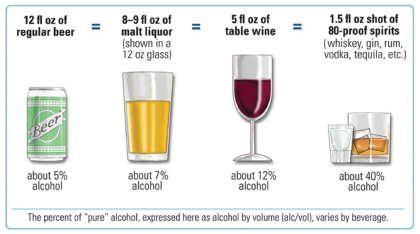
Alcohol
Alcohol is the most common substance used by Canadians, and many have communicated the
The Canadian Centre on Substance Use and Addition has identified a number of harms associated with the over-consumption of alcohol, including chronic health conditions (i.e., cirrhosis of the liver), motor vehicle accidents, suicide, violence, mental illness, and fetal alcohol spectrum disorder (FASD). Harm from alcohol use has also shown to be of particular concern in Aboriginal communities, as well as among youth, seniors and pregnant women. For instance, the 2015 prevalence of past-year use of alcohol among Canadian youth in the 15 to
In response to harms associated with over-consumption, the Canadian federal, provincial and territorial health ministers launched Canada’s Low-Risk Alcohol Drinking Guidelines (LRDG), consisting of guidelines and of tips to help Canadians moderate their consumption and reduce their risks of alcohol-related harm. Experts agree that approaches aimed at reducing the harms associated with alcohol use must be multifaceted – involving key players from the enforcement and justice sectors, an increase of public education, and targeted interventions in settings such as schools, workplaces, and alcohol-drinking establishments.

View Canada’s Low-Risk Alcohol Drinking Guidelines here.
1 Canadian Substance Use Costs and Harms Scientific Working Group. (2018). Canadian substance use costs and harms (2007–2014). (Prepared by the Canadian Institute for Substance Use Research and the Canadian Centre on Substance Use and Addiction.) Ottawa, Ont.: Canadian Centre on Substance Use and Addiction. Retrieved from https://www.csuch.ca/en/report/ ort/
2 Statistics Canada & Health Canada. (2017). Canadian Tobacco Alcohol and Drugs (CTADS): 2015 summary. Retrieved from https://www.canada.ca/en/health-canada/services/canadian-tobacco-alcohol-drugs-survey/2015-summary.html
3 Canadian Centre on Substance Abuse. (2005). Answering the call: National framework for action to reduce the harms associated with alcohol and other drugs and substances in Canada. S.l.: Canadian Centre on Substance Abuse. Retrieved from http://www.ccdus.ca/Resource%20Library/ccsa-011322-2005.pdf#search=all%28ontario%29
